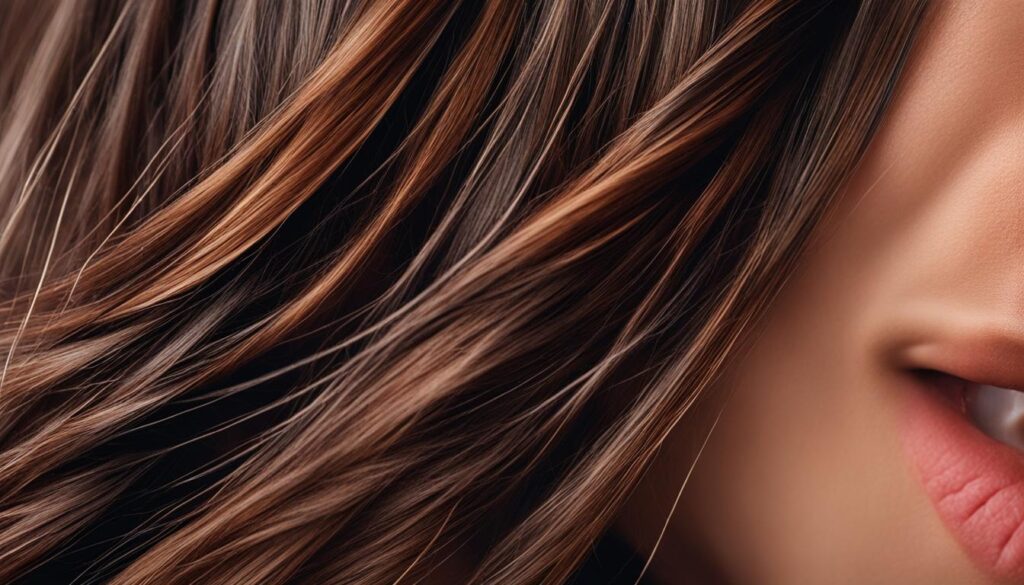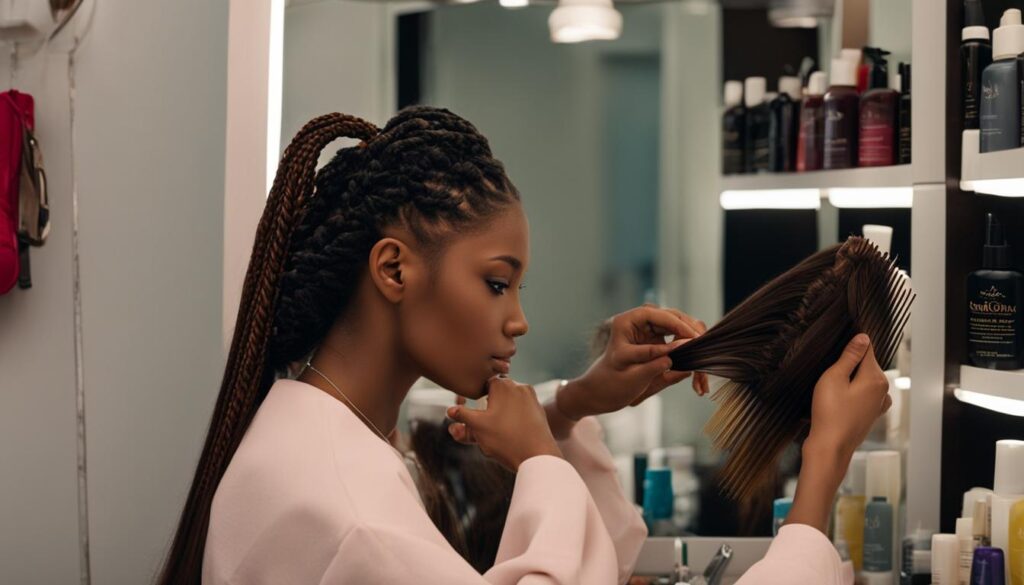
Braids have long been a popular hairstyle choice for their versatility and protective benefits. But what effect do braids actually have on hair growth? Let’s explore the relationship between braids and hair health.
When it comes to hair growth, it’s important to understand that braids themselves don’t directly influence the speed at which your hair grows. Hair growth is primarily determined by factors such as genetics, protein, nutrients, scalp health, and diet. However, braids can play a role in promoting healthier hair growth by safeguarding the strength and moisture of your hair.
Key Takeaways:
- Braids do not directly make your hair grow faster
- Hair growth is influenced by genetics, protein, nutrients, scalp health, and diet
- Braids can protect the strength and moisture of your hair
- Braids help reduce breakage and promote healthier hair growth
- Proper care and maintenance are essential for maintaining healthy braided hair
How Do Braids Help Hair Growth?
Braids can play a significant role in promoting healthier hair growth by providing protection and strength to the hair.
When your hair is braided, it is less prone to breakage and daily wear and tear. The braids act as a shield, preventing your strands from rubbing against clothing or being subjected to friction while you sleep. This protection can help maintain the integrity of your hair and reduce the chances of breakage, allowing it to grow longer and healthier.
In addition to protection, braids also provide structure and support to your hair. By weaving your strands together, braids help distribute the weight of your hair more evenly, reducing stress on individual strands and minimizing the risk of breakage. This added strength can contribute to healthier hair growth over time.
The Benefits of Braiding Your Hair
1. Protection against breakage: Braids act as a barrier, minimizing the contact between your hair and external elements that can cause damage.
2. Reduced friction: Braids help reduce friction between your hair and pillow or other surfaces while you sleep, preventing unnecessary breakage.
3. Structural support: By weaving your strands together, braids provide structural support and distribute the weight of your hair more evenly, minimizing the risk of breakage.
“Braids act as a shield, preventing your strands from rubbing against clothing or being subjected to friction while you sleep.”
| Braid Type | Features |
|---|---|
| Box Braids | Individual braids created with synthetic or natural hair extensions, offering versatility and low-maintenance styling. |
| Ghana Braids | Large, cornrow-like braids that are close to the scalp and often decorated with beads or other accessories. |
| Microbraids | Ultra-thin braids created by tightly weaving small sections of hair, resulting in a delicate and intricate look. |
| Cornrows | Tight braids created by weaving sections of hair close to the scalp, often forming straight lines or intricate patterns. |
| Goddess Braids | Large, chunky braids that can be styled in various ways, offering a glamorous and eye-catching look. |
These are just a few of the many popular braided hairstyles that can help protect and style your hair while promoting healthy hair growth. Remember, it’s important to choose a style that suits your hair type and preferences and to give your hair regular breaks between braided hairstyles to ensure its overall health and well-being.
Benefits of Braiding Your Hair
Braiding your hair can offer numerous benefits beyond just a stylish and trendy look. When done properly, braids can help nourish and hydrate your hair, while reducing breakage and promoting overall hair health.
1. Hair Nourishment and Hydration
Braiding your hair can help lock in moisture and prevent dryness. By braiding your hair with natural oils or leave-in conditioners, you can provide your hair with additional nourishment and hydration. The braids act as a protective barrier, minimizing moisture loss and keeping your hair moisturized and healthy.
2. Reducing Hair Breakage
Braids can help protect your hair from daily wear and tear, reducing the chances of breakage. When your hair is braided, the strands are contained and less prone to tangling, rubbing against clothing, or getting caught in accessories. This helps to minimize breakage and maintain the length and strength of your hair.
“Braiding your hair can be a great way to protect it and reduce the risk of breakage. It’s important to choose a braiding style that is not too tight or heavy, as this can cause stress on the hair follicles and lead to damage.”
3. Versatile Styling Options
One of the greatest benefits of braiding your hair is the versatility it offers in terms of styling options. Whether you prefer classic box braids, trendy cornrows, or elaborate goddess braids, there are endless possibilities to suit your personal style and preferences. Braided hairstyles can be worn for various occasions and can last for weeks with proper care, making them both convenient and fashionable.
Braiding your hair not only provides a stylish look but also offers several benefits for its health and strength. By ensuring proper nourishment and hydration, reducing breakage, and exploring the versatile styling options, you can enjoy the advantages of braided hair while maintaining overall hair health.
Can Braids Damage Your Hair?
Braids have long been a popular hairstyle due to their ability to protect and style the hair. However, it is important to be aware that improper braiding techniques or wearing tight braids for extended periods can potentially damage your hair. The sustained pressure on the hair follicles from tight braids can lead to hair breakage and even traction alopecia, a condition characterized by hair loss caused by tension on the hair strands.
It is crucial to strike a balance between the desire for stylish braided hairstyles and the health of your hair. When getting braids installed, make sure to communicate with your stylist about the desired level of tightness. Avoid excessive tension on the scalp and hair follicles, as this can cause unnecessary damage. Additionally, if you notice any discomfort or pain while wearing braids, it is essential to address it promptly to prevent further harm to your hair.
“Tight or heavy braids can pull on the hair follicles and cause damage, leading to conditions like traction alopecia.”
To prevent hair breakage, it is recommended to take breaks between braided hairstyles and not leave them in for an extended period. Regularly removing and reinstalling braids allows the hair and scalp time to recover and reduces the risk of sustained damage. When removing braids, be gentle and avoid pulling or tugging on the hair strands. Use a moisturizing conditioner or oil to help detangle the hair and reduce breakage during the removal process.
| Signs of Braiding-Related Hair Damage | Preventive Measures |
|---|---|
| Thinning hair or bald spots near the hairline or scalp | Choose looser braids and avoid excessive tension |
| Scalp tenderness, pain, or itching | Communicate any discomfort to your stylist and remove braids if necessary |
| Hair breakage or excessive shedding | Take breaks between braided hairstyles, properly moisturize the hair, and avoid using heavy extensions |
By being mindful of the tension and duration of braided hairstyles, you can enjoy the benefits of braiding while minimizing the risk of damage. Remember to prioritize the health of your hair and scalp, and consult a professional stylist if you have any concerns or questions regarding the proper care and maintenance of your braided hair.

Popular Braided Styles
If you’re looking to experiment with braided hairstyles, there are plenty of popular options to choose from. Whether you have long or short hair, curly or straight, there’s a braided style that will suit your preferences. Let’s explore some of the most sought-after braided hairstyles:
1. Box Braids
Box braids are a classic choice that involves sectioning the hair into small squares and braiding extensions into each section. This style is versatile and can be customized with various lengths and colors.
2. Ghana Braids
Ghana braids, also known as cornrows or invisible braids, are formed by braiding the hair very close to the scalp. This style can be worn in various patterns and can even be styled into creative shapes.
3. Microbraids
Microbraids are tiny, delicate braids that are great for adding a touch of intricacy to your hairstyle. They require a lot of time and patience to install, but the end result is worth it.
4. Cornrows
Cornrows are a classic African hairstyle that involves braiding the hair close to the scalp in straight lines or intricate patterns. This style is versatile and can be worn in various sizes and shapes.
5. Goddess Braids
Goddess braids are chunky, large braids that can be styled in various ways. They are usually braided close to the scalp and can be adorned with beads or other accessories to add an extra touch of elegance.
6. French Braid
The French braid is a timeless and elegant style that involves three strands of hair woven together from the top of the head to the nape of the neck. It is a versatile style that can be worn for casual or formal occasions.
7. Dutch Braid
The Dutch braid, also known as an inverted braid, is similar to the French braid but with a reversed technique. Instead of crossing the strands over, they are crossed under, creating a more pronounced, raised braid.
8. Fishtail Braid
The fishtail braid is a beautiful and intricate braid that resembles the tail of a fish. It is created by dividing the hair into two sections and taking small strands from each section to cross over and intertwine.
These are just a few examples of the many popular braided hairstyles available. Whether you prefer a sleek and polished look or a more bohemian and textured style, braids can provide endless options for expressing your personal style.
How to Care for Braided Hair
Proper care is essential for maintaining healthy and beautiful braided hair. Follow these tips to ensure your braids stay in great condition:
Washing and Moisturizing Braids
While your braids are in, it’s important to keep your scalp and braids clean to prevent buildup and maintain a healthy environment. Use a diluted shampoo or a specially formulated braid cleanser to gently cleanse your scalp and roots. Focus on the scalp and avoid excessive rubbing or pulling on the braids. Rinse thoroughly to remove all product residue.
After washing, it’s crucial to moisturize your braids to prevent dryness and breakage. Apply a lightweight leave-in conditioner or a moisturizing spray to your braids, focusing on the ends. You can also use natural oils like argan oil or jojoba oil to add hydration. Gently massage the product into your scalp to improve circulation and promote a healthy environment for hair growth.
Protecting Braids at Night
Protecting your braids while you sleep is essential to prevent frizz, tangling, and damage. Use a satin or silk scarf or bonnet to cover your braids at night. These materials are gentle on your hair and help to retain moisture. Alternatively, you can use a satin or silk pillowcase to minimize friction and maintain the integrity of your braids. Avoid sleeping with your braids loose as this can lead to unraveling and potential breakage.
Maintaining Braids
While braids can last for several weeks or even months, it’s important to monitor their condition and make necessary adjustments. If you notice any excessive tightness or discomfort, consider loosening your braids to alleviate tension on your scalp. Avoid pulling or tugging on individual braids as this can lead to breakage or damage to the hair follicles.
Additionally, avoid excessive heat styling or using harsh chemical treatments on your braids, as this can weaken the hair and lead to breakage. Opt for protective styles that don’t require excessive manipulation or tension on the hair.

| Braided Hair Care Tips | DOs | DON’Ts |
|---|---|---|
| Washing | – Use a diluted shampoo or braid cleanser | – Scrubbing or rubbing the braids vigorously |
| Moisturizing | – Apply leave-in conditioner or moisturizing spray | – Using heavy products that can cause buildup |
| Protecting | – Cover with a satin or silk scarf or bonnet at night | – Sleeping without protecting the braids |
| Maintaining | – Loosen braids if they’re too tight | – Pulling or tugging on individual braids |
Conclusion
In conclusion, it is important to address common hair growth myths surrounding braids. While braids alone do not directly promote hair growth, they can have a positive impact on hair health.
Factors such as genetics, protein, nutrients, scalp health, and diet play a significant role in hair growth. Braids, however, can help protect and nurture the hair, reducing breakage and promoting healthier hair growth.
By properly caring for your braided hair and taking a holistic approach to hair care, you can ensure the overall health and strength of your hair. Remember to wash, moisturize, and detangle your hair before braiding, regularly clean and moisturize your scalp while the braids are in, and protect your braids at night by wearing a headscarf or wrap. Additionally, it is advised to remove the braids after a maximum of two months to prevent damage and promote hair and scalp health.
In essence, while braids may not be a magical solution for hair growth, they can serve as a method of protecting and maintaining your hair’s health. By incorporating braids into your hair care routine and paying attention to other important factors, you can positively impact the overall condition of your hair.
FAQ
Do braids slow hair growth?
No, braids do not directly slow hair growth. Hair growth is primarily influenced by genetics, protein, nutrients, scalp health, and diet.
How do braids help hair growth?
Braids can help promote hair growth by protecting the strength and moisture of your hair, reducing breakage, and providing structure and strength to the hair.
What are the benefits of braiding your hair?
Braids can protect your hair by preventing breakage, minimizing daily wear and tear, reducing friction between the hair and pillow while sleeping, locking in moisture, and promoting healthier hair growth.
Can braids damage your hair?
Yes, braids can potentially damage your hair if they are left in for too long or if they are pulled too tightly during installation. It is important to loosen your braids, take breaks between styles, and massage the scalp with essential oils to prevent damage and promote healthy hair growth.
What are some popular braided styles?
Popular braided hairstyles include box braids, Ghana braids, microbraids, cornrows, goddess braids, French braid, Dutch braid, and fishtail braid. These styles can be worn by individuals with different hair textures and lengths.
How should I care for braided hair?
To maintain healthy braided hair, it is important to wash, moisturize, and detangle the hair before braiding. Regularly clean and moisturize the scalp while the braids are in, protect them by wearing a headscarf or wrap at night, and remove the braids after a maximum of two months to prevent damage and promote hair and scalp health.
Do braids promote hair growth?
While braids alone do not directly promote hair growth, they can help protect and nurture the hair, reducing breakage and promoting healthier hair growth. However, other factors such as genetics, protein, nutrients, scalp health, and diet play a significant role in hair growth.






